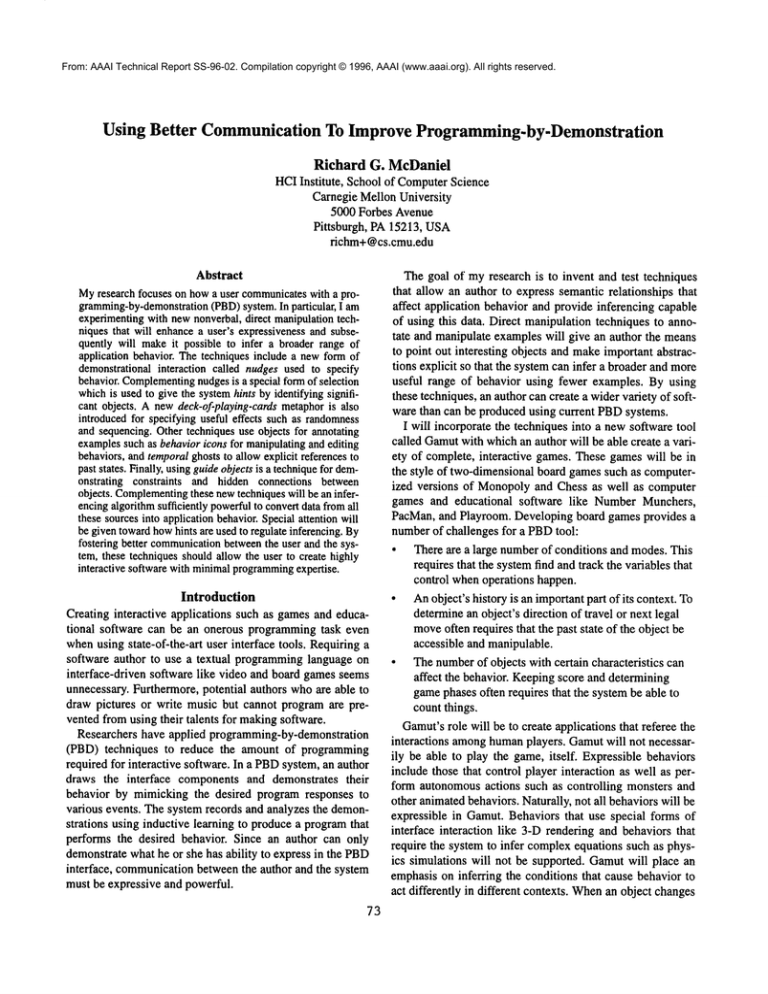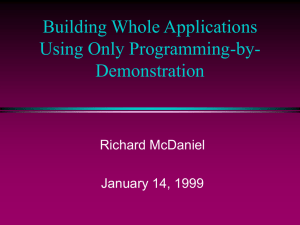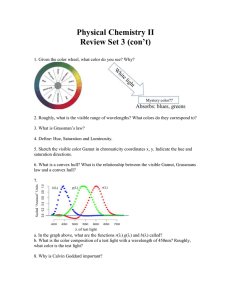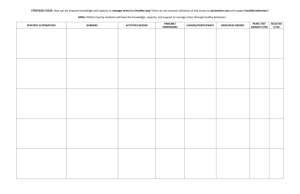Using Better Communication To Improve Programming-by-Demonstration
advertisement

From: AAAI Technical Report SS-96-02. Compilation copyright © 1996, AAAI (www.aaai.org). All rights reserved. Using Better CommunicationTo Improve Programming-by-Demonstration Richard G. McDaniel HCIInstitute, School of ComputerScience Carnegie Mellon University 5000 Forbes Avenue Pittsburgh, PA15213, USA richm+@cs.cmu.edu Abstract Myresearch focuses on howa user communicates with a programming-by-demonstration (PBD)system. In particular, I experimentingwith newnonverbal, direct manipulationtechniques that will enhancea user’s expressivenessand subsequently will makeit possible to infer a broader range of application behavior. The techniquesinclude a newformof demonstrationalinteraction called nudgesused to specify behavior.Complementing nudgesis a special formof selection whichis usedto give the systemhints by identifyingsignificant objects. Anewdeck-of-playing-cardsmetaphoris also introducedfor specifying useful effects such as randomness and sequencing.Othertechniquesuse objects for annotating examplessuch as behavioricons for manipulatingand editing behaviors,and temporalghosts to allowexplicit referencesto past states. Finally,usingguideobjectsis a techniquefor demonstrating constraints and hidden connections between objects. Complementing these newtechniqueswill be an inferencingalgorithmsufficiently powerfulto convertdata fromall these sourcesinto applicationbehavior.Specialattention will be giventowardhowhints are usedto regulate inferencing.By fostering better communication betweenthe user and the system, these techniquesshouldallow the user to create highly interactive softwarewithminimalprogramming expertise. Introduction Creating interactive applications such as gamesand educational software can be an onerous programmingtask even whenusing state-of-the-art user interface tools. Requiringa software author to use a textual programminglanguage on interface-driven software like video and board gamesseems unnecessary. Furthermore, potential authors whoare able to draw pictures or write music but cannot program are prevented from using their talents for makingsoftware. Researchers have applied programming-by-demonstration (PBD) techniques to reduce the amount of programming required for interactive software. In a PBDsystem, an author draws the interface components and demonstrates their behavior by mimicking the desired program responses to various events. The system records and analyzes the demonstrations using inductive learning to producea programthat performs the desired behavior. Since an author can only demonstratewhat he or she has ability to express in the PBD interface, communicationbetween the author and the system must be expressive and powerful. 73 The goal of myresearch is to invent and test techniques that allow an author to express semantic relationships that affect application behavior and provide inferencing capable of using this data. Direct manipulation techniques to annotate and manipulate exampleswill give an author the means to point out interesting objects and makeimportant abstractions explicit so that the systemcan infer a broader and more useful range of behavior using fewer examples. By using these techniques, an author can create a widervariety of software than can be produced using current PBDsystems. I will incorporate the techniques into a newsoftware tool called Gamutwith whichan author will be able create a variety of complete, interactive games. These gameswill be in the style of two-dimensionalboard gamessuch as computerized versions of Monopolyand Chess as well as computer games and educational software like NumberMunchers, PacMan, and Playroom. Developing board games provides a numberof challenges for a PBDtool: ¯ There are a large numberof conditions and modes. This requires that the systemfind and track the variables that control whenoperations happen. ¯ Anobject’s history is an importantpart of its context. To determinean object’s direction of travel or next legal moveoften requires that the past state of the object be accessible and manipulable. ¯ The numberof objects with certain characteristics can affect the behavior. Keepingscore and determining gamephases often requires that the systembe able to count things. Gamut’srole will be to create applications that referee the interactions amonghumanplayers. Gamutwill not necessarily be able to play the game, itself. Expressible behaviors include those that control player interaction as well as perform autonomousactions such as controlling monsters and other animatedbehaviors. Naturally, not all behaviors will be expressible in Gamut.Behaviors that use special forms of interface interaction like 3-D rendering and behaviors that require the system to infer complexequations such as physics simulations will not be supported. Gamutwill place an emphasis on inferring the conditions that cause behavior to act differently in different contexts. Whenan object changes the piece Authorwants a piece to movewhedragged. Nothil g happens,so ~uthorswitche:to Response ater, t.iamutw:II move Whileprogramis running, author clicks down Modeand "nudges"Gamutby dragging the piece automatically. onpiece, drags,andlifts buttonat destination. manually.(Grayedobjects are temporalghosts.) Figure 1: Using NudgesTo DemonstrateAn Interaction state, the author will be able to instruct the systemwhythe behavior has occurred as well as what the behavior does. Techniques Gamutdefines newforms of interactions including hints, nudges, a deck-of-playing-cards metaphor, guide objects, modeswitches, behavior icons, temporal ghosts, a timeline view, and a counting sheet. Nudges and Hints Authors demonstrate system behavior by running the game. Whenthe author first performs an event, the system does not respond. The author then corrects the system by switching into response modeand modifying the objects as they are supposedto be affected by the program.In essence, the author nudges the system to perform the correct behavior. If the system continues to perform incorrect behavior, new examples are demonstrated by nudging the system again. An exampleof nudging is shownin Figure 1. Thesystemdefines two nudgesfor certain situations. First, the Do Something/nudge will be used when a behavior has been demonstrated to the system, but some objects do not respond. Whenthe unresponsive objects are selected and DoSomething/is pressed, the systemwill search for a previously learned behavior that can be generalized to include the selected objects. Second, the Stop That/nudge will be used whena behavior performs undesired actions on objects. The systemcomparesthe current state to previous times whenthe behavior succeeded and determine howto makethe behavior conditional. Several prior systems such as Frank’s Grizzly Bear [2] have used an extended macro-recorder metaphorfor collecting demonstrations. A macro-recorder stores operations by having the author transfer into a special modewherethe system will remembereach action the author performs. The extended macrorecorder adds a second modeto this scheme for recording stimulus events. First, the author switches on stimulus modeto demonstrate the event, then he or she 74 switches to response modeto demonstrate the actions. This makes creating a behavior a two-step process, both phases requiring the author to anticipate and set up the environment so that the demonstrationwill proceed without a mistake. The purpose of nudges is to simplify the way that an author specifies behavior. Instead of demonstratingstimulus and response separately, the author only shows responses. The stimulus is inferred by observing what events the author performed most recently before demonstrating a response. Also, by using Stop That/, the author generates negative examplesimplicitly. The macro-recorder technique requires the author to indicate first that a negative exampleis about to be shown, then the author must purposely force the system into a state in whichit is not allowedto be. This requires that the author know what situations the system has guessed incorrectly before the system has shown any problems. Using nudges, the author must only identify that the system madea mistake after it has happened.Correcting the mistake can be accomplished immediately and does not require the author to formulate a newdemonstration from scratch. To point out importantobjects that relate indirectly to the demonstratedbehavior, the author will use highlighting for hints. Maulsby’sTurvyexperimentsstudied hints as well [4], but Gamutwill be the first to apply hints in an interactive domain.Hints are neededto distinguish the causes for conditional behavior. Even in a small application, the numberof possible conditions that could affect a given behavior are too numerous to generate and test. By allowing the author to highlight objects that are significant to the behavior, a system can narrow the numberof choices to arrive at a reasonable guess. In Figure 1, the author highlights the two mouse pointer ghost objects (described later) to note that the cursor affects which object is movedand where it goes. Hints are especially useful when the author performs a Stop That/ nudge because Stop That/indicates that a behavior is conditional. Objects can be highlighted during any demonstration even if the reason for the hint will not becomeapparent until later. Deck of Cards Anauthor will be able to use the deck-of-playing-cards metaphorto specify a variety of effects. Cardscan be used to perform randomevents like the Chancedeck in Monopolyor to movepieces as in PacMan.First, the author builds an appropriate deck by assigning graphics and properties to each card. The author can then demonstrate howto use the deck such as whento shuffle or whereto play a card as the game progresses. By having the system play cards autonomously, objects like video game monsters can be made to moveon their own, as shownin Figure 2. 1. Builddeckof four cardswith an arrowpointingin eachdirection. 2. Shufflethe deck. 3. Copyarrowfromtop card onto monster andhavemonsterfollowthe arrow. n Shuffle| Figure 2: Using Cards to Movea Monster Playing cards can be used to perform many commonprogrammingalgorithms that use a list of elements data structure such as stacks, queues, and dictionaries. By presenting this data structure as a deck-of-cards, its operations become more concrete. The metaphor also helps the author understand and control aggregate operations such as sorting, searching, and aggregating properties. For instance, one might sum the VALUE property of each card in a player’s hand to determinea final score. Annotation Objects Annotation objects are objects that an author uses during editing to build or manipulate relationships and behaviors. They appear as visible graphics while the programis edited but disappear whenit is run. Guide objects, modeswitches, behavior icons, and temporal ghosts will all be annotation objects in Gamut. Guide Objects Lines and rectangles can be used as annotations to show connections and graphical constraints between objects. DemoII by Fisher et al. [1] used a similar technique called guidewires. By placing the guide objects in important locations, positions and relationships can be maintained even whenno visible objects are involved. For instance, one can configure a table for a card gameby laying out rectangles at places where cards are placed. Lines and arrows can be used 75 as directions and paths for movingobjects as shownin Figure 2. Mode Switches Modeswitches allow the author to easily specify different application modes. For instance, a modeswitch can be used to control whichplayer’s turn is current. To build Pacman,a modeswitch can be used to control changes betweenthe normal modewhen monsters are dangerous and the modewhere monsters turn blue and can be eaten by the Pacman. To build modalbehavior, the author first creates a mode switch and specifies howmanystates the switch will have. To change the mode, the author switches the mode switch and demonstrates howthe application objects are affected. For instance, in Pacman,whenthe modeswitch is set to blue mode,the author colors the monsters blue, deletes the monsters’ "run towards" behavior, and replaces it with a "run away" behavior. Behavior Icons Gamutwill represent behaviors with small icons placed near the objects they affect. Theseicons can be selected and highlighted just like any other object. By using cut, copy, and paste operations, the author can transfer a behavior from one object to another. The system will infer howthe behavior must change to work in the different context. The icons mayalso be selected and expandedto present extra information about their behavior. This can be used to view a textual representation or to modifythe behavior’s parameters. Temporal Ghosts Manyrules in board games rely on the prior state of objects. For instance, a piece’s legal movesmaybe relative to its current position. To allow the author to makeexplicit connections to the past, Gamutwill showa dimmed,translucent imageof the object in its prior state as in Figure 1. A similar technique was used to record cursor positions in Marquise [6] so that the author could specify howobjects behave with respect to cursor events. Gamutgeneralizes this to all objects. Timeline and Counting Sheet Views The author will be able to control the number of ghost objects as well as makethe application run back and forth in time with the timeline view. In the timeline, events and actions are displayed graphically, permitting the author to highlight and manipulate them. To keep score or keep track of other numbers, the author will use the counting sheet. Like a spreadsheet for data descriptions, the counting sheet will describe various numeric properties about the game. The numbers will be able to be used as events to initiate other behaviors such as switching to a new round or ending the game. Feedback And Representations A major concern for PBDsystems is howshould it tell the user what it has inferred in an understandable and concise way. Somesystems in the past have provided no feedback at all. Demonstrations would be inferred without the author knowing what would happen until the program was tested later. Other systems provide a secondary windowthat displays the system’s inferences as programmingcode. Graphical representations have been shownto be one of the most understandable forms of feedback for novice users [5]. This is why Gamutavoids using language representations as muchas possible and uses graphical representations for the majority of its techniques. Gamutuses a variety of feedback methods. Behavior has manyfacets and different views are needed for each. One basic requirement is that all data in a Gamutprogram be completely visible and accessible. This same principle was embodied in Gould and Finzer’s Rehearsal World [3] with some success and has since been commonin many PBD environments. As in Rehearsal World, Gamut’sdata will be exposed as widgets. Some of the widgets are grouped together such as the counting sheet where multiple numberbased widgets are collected in one place, and the deck-ofcards which collects multiple card widgets. All data is exposedso that the author can see the state of the programat a glance and see potential problems as soon as possible. Changesin the backgrounddata do not always affect the visible screen objects immediately which leads to confusion later whenthe screen objects do misbehave. By makingthe data visible, someerrors can be corrected sooner and more directly because the author can point directly to the errant data before it causes problems. Just as importantas being able to see the data is being able to examinethe behaviors that affect the data. This is an area of active research and one of the areas where Gamut’snew techniques are used. Each kind of annotation object can be considered a form of graphical feedback in Gamut. Guide objects can show what path an object will follow or how objects are interrelated. Behavioricons are a graphical representation for behavior and makeit possible to see which objects have associated behaviors and which do not. Temporal ghosts showthe relationship between the previous and current state of the program. Andmodeswitches are a graphical representation for sources of conditions. The graphical annotations in Gamutare meant to suggest to the author howobjects will respond to behaviors. Unlike a language-basedtechnique, the annotations are not precise in that they are not necessarily self-describing. Seeing a guide line connecting two objects in a programcould meanpotentially anything to someonewhois viewing it for the first time. Often, an annotation’s use becomesapparent whenthe programis run, but not always. One solution is to provide a language that describes what a behavior will do. This language can be viewed upon request so that nonprogrammers 76 need not look at it if not desired. One potential problem arises, though, if Gamutallows the author to modify a behavior using this language. Originally, the code would have been generated by Gamutmakingit feasible for the system to reason about the behavior and change it whennecessary. If the author hand modifies the code too muchor in a unexpected way, it can becometoo difficult for Gamutto reason with the code any longer. Feedback must also be provided to tell the author what will happen when a behavior is run. The temporal ghosts show the previous state and the timeline view provides a fine-grained history of past actions and events. The author can see precisely what has happenedby reading the actions on the timeline. Thoughthe timeline is essentially a textual formof feedback, it is stripped of all proceduralcodesuch as conditions and loops so that it can be read as a simple list of actions. The timeline allows the author to replay events and is the chief means for controlling programexecution. Commondebugging operations such as single stepping are also provided by the timeline by replaying only some of the actions at a time. Implementation Converting the data expressed using Gamut’s techniques into a usable application is the job of the inferencing system. Inferencing involves two components:the knowledgerepresentation whichdictates the form in whichinferences will be generated and the inferencing algorithm which converts the demonstrations into the knowledgerepresentation. Knowledge Representation There are two forms of knowledge that will be used in Gamut.The first form represents the learned gamebehavior. It consists of programmingconstructs such as operations, loops, and conditions which form the structure which causes the gameto respond to the user. The kinds of operations Gamutmust support include: creating and deleting objects, movingobjects, and changing object properties. The parameters for Gamut’s operations are data descriptions which describe which objects the behavior affects. Gamut’s data descriptions must be able incorporate many factors and be able to refer to objects indirectly. For instance in Monopoly,players roll dice to determinethe next position for their pieces. The description for the next position might be "the square that is the dice roll’s numberof spaces away from the square where the current player’s piece started." This description uses information from several sources including the dice, the board, whothe current player is, and the current location of a piece. Furthermore, muchof the informationis described relative the other factors. The second form of knowledgeis the permanent store of rules that specify howboard gameelements are assembled. These rules are used to guess relationships betweenobjects such as how objects are positioned or how to interpret a change between players. This knowledge is stored in the form of algorithms and methodsassociated with the various objects and property types that the author manipulates. For instance, shuffling algorithms are attached to deck-of-playing-cards objects, path algorithms are attached to guide objects, and numberheuristics are attached to numericproperties. These algorithms and methodsare invoked while the author manipulates data and demonstrates behavior to provide a source of information for the inferencing algorithm. lnferencing Algorithm Gamut’sinferencing can be best likened to the artificial intelligence field called plan recognition [7]. A plan recognition system watches a sequence of actions which is normally provided by a humansource. The goal of the system is to label the sequencewith a higher-level description that captures the meaningof the actions and explains the reason why the actions occurred. Gamutwatches actions performed in a graphical editor and analyzes the sequence as actions that would be performed in a game. At present, I do not know exactly which algorithms will work best for Gamut.Since this workshopwill host a numberof AI researchers, it will provide an opportunity to learn more about inferencing and discuss better algorithms for myownresearch. Critical to Gamut’sinferencing will be the ability to search prior behaviors for various attributes. Whenthe author asks the system to DoSomething.t, the system will need to search for behaviors whichuse the sameevents as the one just demonstrated. Likewise, whena behavior icon is movedto a new object, the structure of the associated behavior will have to be searchedfor its relationship to the newobject. Joining the branches of a conditional behavior requires that the two sequences be comparedto find the point where they perform identical operations. User Interface Experiment Gamutis a relatively large systemfor a research project. This mandatesthat the first step be to test these ideas early before needless work is performed implementingtechniques that users will not like or will not understand. Therefore, I will design an informal, paper prototype experiment to test Gamut’smainconcepts and techniques. In a paper prototype, one builds a mock-upof the computerinterface using paper and cardboard cutouts. These pieces will be used to act out Gamut’stechniques such as nudges, hints, deck-of-playingcards, the timeline, and a limited set of annotation objects. Since the systemmust be acted out manually, behavior icons, the counting sheet, and modeswitches will be left out to makethe experimenteasier to run. For the experiment, subjects will be expected to demonstrate a series of behaviors. Someof the behaviors will require a degree of creativity on the subjects’ behalf. If the 77 techniques work well, the subjects should never be stymied by any of the problems, thoughthey will likely have to think through a few problems. The goal is to see which techniques the subject understands best and howthe subject uses them to solve a problem. For the initial runs, subjects will be allowedto design their ownwidgets and interaction methods. Thoughthis mayjust lead to fanciful ideas that cannot be implemented,I expect that allowing this will produce someinsight into howusers understand the problem. Because the experiment is informal, I will be able to modifythe experiment betweensessions to try out different ideas morequickly. The results from this experiment should be ready in time for the workshoppresentation. Conclusion By designing techniques to foster better communication betweenauthor and system, it will be possible to makemore powerful inferences with fewer examples. Part of the research will investigate how the techniques affect an author’s perception of a programmingtask. Also, since this research uses a variety of techniques, it will he possible to investigate howauthors learn and use Gamut’stechniques as well as how authors conceptualize game behaviors in Gamut’s framework.Havingthese techniques in a single tool will aid the investigation as well as provide authors with a powerful environmentfor building interactive applications while requiring minimal programmingexpertise. References [1] GeneL. Fisher, Dale E. Busse, David A. Wolber. Adding Rule-BasedReasoning to a Demonstrational Interface Builder. Proceedingsof UIST’92,pp 89-97. User Interface Designby Demon[2] Martin Frank. Model-Based stration andby Interview.Ph.D.thesis. Graphics,Visualization &Usability Center, GeorgiaInstitute of Technology, Atlanta, Georgia. [3] Gene L. Fisher and William Finzer. Programmingby Rehearsal. Palo Alto Research Center, XeroxCorporation, 1984. [4] DavidMaulsby.Instructible Agents.Ph.D.thesis. Department of Computer Science, Universityof Calgary,Calgary,Alberta, June 1994. [5] FrancesmaryMudugno,T.R.G. Green, Brad A. Myers.Visual Programming in a Visual Domain:A Case Study of Cognitive Dimension.ProceedingsHuman-Computer Interaction 1994, PeopleandComputers,Glasgow,August,1994. [6] Brad A. Myers, Richard G. McDaniel,and DavidS. Kosbie. Marquise:Creating CompleteUser Interfaces by Demonstration. Proceeding of 1NTERCHI’93: HumanFactors in Computing Systems,1993, pp. 293-300. [7] Stuart J. Russell,Peter Norvig.Artificial Intelligence:AModemApproach.Prentice Hall, Englewood Cliffs, NewJersey 07632,1995.p. 654.



